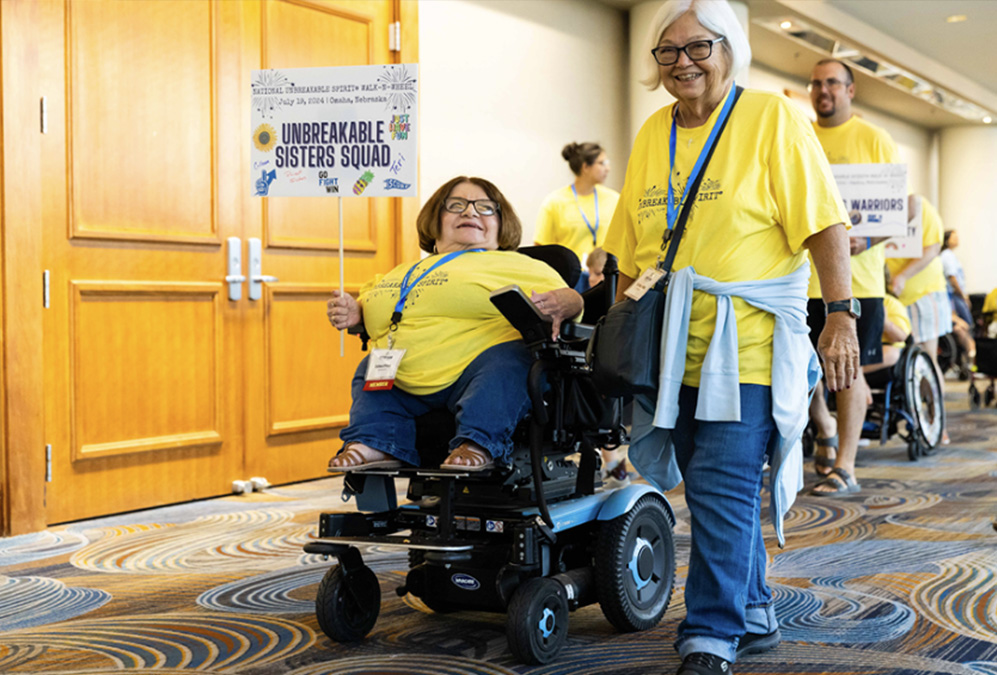Non-Skeletal Issues in OI

SHARE
Non-Skeletal Issues in OI
Early definitions of OI refer to a syndrome of fragile bones and hearing loss. This suggests that the problems seen in people with OI include more than just brittle bones. In dominant OI, the mutation in type 1 collagen affects not only the skeleton but also the collagen-rich tissues in other organ systems. The non-skeletal clinical features of OI vary in the degree of severity. In some instances, age is also a factor. Research is needed to fully understand the prevalence and best approach to the management of non-skeletal issues in OI.
More detailed information and recommendations for many of the following topics is provided in the supporting documents for this section.
- Dental Oral-Facial: OI affects the growth of both jaws and tooth development. About 50% of people with OI have dentinogenesis imperfecta (DI). Regular dental care is recommended for all people with OI beginning within 6 months after the primary teeth erupt and continuing throughout life. Other common oral cavity problems related to OI include: impacted teeth, anterior and posterior open and crossbites and skeletal class III malocclusion.
OIF Podcast: Craniofacial and Dental Issues in OI - Pulmonary Care:Respiratory problems can seriously diminish a person’s quality of life and are a leading cause of OI-related death. The primary respiratory problem affecting people with OI is loss of lung capacity. Other problems include ineffective cough, poor secretion clearance, airway diseases such as asthma, sleep apnea, and low oxygen.
There are two main causes of lung problems specifically related to OI: abnormalities of lung tissue and abnormal chest wall architecture (the size and shape of the chest cavity). In addition, limited mobility and the effects of gastrointestinal problems such as constipation and reflux all contribute to poor pulmonary function.
Viral infections (colds and flu), bacterial infections (bronchitis and pneumonia), and allergies are common respiratory problems. Even when lung problems are not directly caused by OI, they can be more severe in people who have OI. Respiratory conditions are the leading cause of death for people with OI. For that reason, people with OI must protect their pulmonary systems from all types of viruses and be attentive to air quality alerts.
OIF Podcast: Pulmonary Issues and OI - Hearing: Approximately 50% of adults with OI have a measurable hearing loss, which typically arises in the second or third decade of life. Bone quality and structural abnormalities of the ear bones, including visible deformities in the ossicles and the inner ear- contribute to the loss. Environmental factors affecting hearing may cause a loss sooner than the unaffected population. Most hearing loss in OI is mixed but conductive, and sensorineural types of loss are seen. There is a range of severity, and some people report experiencing tinnitus and vertigo. Treatments include hearing aids and/or surgery such as stapedectomy or cochlear implant. Physicians should be alert to the dangers of ototoxins in this population.
OIF Podcast: Hearing Loss in Patients with OI - Cardiac Care There are compelling data that suggest some cardiovascular problems are more prominent in individuals with OI, but the information is scattered and to-date there have been no complete evaluations of the literature concerning pathophysiology, epidemiology, and clinical characteristics. Studies have shown that a small number of adults with OI have heart valve problems. The most common is called mitral valve prolapse, but other valves may also be affected. Dilation of the aorta also may occur. High blood pressure (hypertension) is as common among adults with OI as in the rest of the population. High cholesterol and related lipid disorders that may occur in families can contribute to heart problems as well.
- Neurological: Intelligence is typically normal in people with OI. People with all subtypes of OI may develop basilar impression (BI) over time, with those with severe OI having greater risk. Enlarged head circumference is seen in infants and children with OI and may or may not be caused by hydrocephalus. Evaluation is required; shunting is possible.
- Vision: People with OI seem to experience common refractive errors such as myopia, hyperopia, or astigmatism at about the same rate as people without OI. More serious conditions like glaucoma or retinal detachment are seen in adults, with the rate of incidence unknown. Blue sclerae, a frequently described finding, may be associated with corneal thinning. Scleral thickness is normal in OI Type I, but may be thin in other types of OI.
- Connective Tissue: Blood Vessels, Skin, Tendons, and Ligaments: Thin blood vessels and thin skin may cause people with OI to bruise easily. The skin of people with OI may be stiffer and less elastic, which can increase the risk of scarring. Reduced muscle strength may be significant for people with moderate and severe forms of OI. Joint laxity is common and contributes to frequent sprains and dislocations, particularly of the ankles, hips, shoulders, thumbs, and elbows. Flat feet are common, particularly in people with Type I OI. Hernias may be present at birth and occur more frequently in children with OI than in the general population.
- Endocrine: People with more severe forms of OI are often short; however, growth hormones and other hormones are typically normal. Excessive diaphoresis has been reported in individuals with all types of OI. Young women with OI may start menstruating later than young women without OI.
- Gastrointestinal: Constipation is common in both children and adults with OI. Spine, hip, and pelvic deformities contribute to this constipation in severely affected children. Treatments include diet, hydration, physical activity, and medication. Celiac Disease, gluten sensitivity, and colitis are reported in children, teens, and adults with all types of OI, but it is not clear if these are more common in people with OI.
- Pain: People who have OI experience acute pain from an injury, surgical pain, and varying degrees of chronic pain. Back pain may be due to compression fractures of the spine or spine curves (such as scoliosis or kyphosis). Some people may have pain without evidence of a fracture. Adequate pain management is essential to maintaining mobility and quality of life for people with OI. People with OI feel the same level of pain as others but may complain less because they experience pain more often than others.
References
Glorieux FG (Ed.) (2007) Guide to Osteogenesis Imperfecta for Pediatricians and Family Practice Physicians. Gaithersburg, MD: Osteogenesis Imperfecta Foundation.
Shapiro J., Byers PH, Glorieux FG, Sponseller PD (Eds.) (2014). Osteogenesis Imperfecta: A Translational Approach to Brittle Bone Disease 1st edition. New York, NY: Elsevier Academic Press.
Attribution
Thank you to Dr. V. Reid Sutton, Baylor College of Medicine & Texas Children’s Hospital, Houston, TX, for reviewing this section. March 2015
Related OIF Podcast Episodes
Hearing Loss in Patients with OI
The Importance of Treating the “Whole” Person with OI
Helping our community stay up to date and connected.
Please sign up to receive updates from the OI Foundation including our monthly e-Newsletter, research updates, and upcoming event information.

